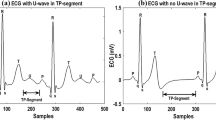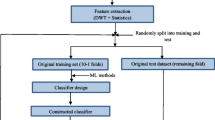Abstract
Sudden cardiac arrest is one of the leading causes of death in the industrialized world. Pulse detection is essential for the recognition of the arrest and the recognition of return of spontaneous circulation during therapy, and it is therefore crucial for the survival of the patient. This paper introduces the first method based exclusively on the ECG for the automatic detection of pulse during cardiopulmonary resuscitation. Random forest classifier is used to efficiently combine up to nine features from the time, frequency, slope, and regularity analysis of the ECG. Data from 191 cardiac arrest patients was used, and 1177 ECG segments were processed, 796 with pulse and 381 without pulse. A leave-one-patient out cross validation approach was used to train and test the algorithm. The statistical distributions of sensitivity (SE) and specificity (SP) for pulse detection were estimated using 500 patient-wise bootstrap partitions. The mean (std) SE/SP for nine-feature classifier was 88.4 (1.8) %/89.7 (1.4) %, respectively. The designed algorithm only requires 4-s-long ECG segments and could be integrated in any commercial automated external defibrillator. The method permits to detect the presence of pulse accurately, minimizing interruptions in cardiopulmonary resuscitation therapy, and could contribute to improve survival from cardiac arrest.




Similar content being viewed by others
References
Alonso E, Aramendi E, Daya M, Irusta U, Chicote B, Russell JK, Tereshchenko LG (2016) Circulation detection using the electrocardiogram and the thoracic impedance acquired by defibrillation pads. Resuscitation 99:56–62
Alonso E, Eftestøl T, Aramendi E, Kramer-Johansen J, Skogvoll E, Nordseth T (2014) Beyond ventricular fibrillation analysis: Comprehensive waveform analysis for all cardiac rhythms occurring during resuscitation. Resuscitation 85(11):1541–1548
Babbs CF (2013) We still need a real-time hemodynamic monitor for cpr. Resuscitation
Berg RA, Hemphill R, Abella BS, Aufderheide TP, Cave DM, Hazinski MF, Lerner EB, Rea TD, Sayre MR, Swor RA (2010) Part 5: Adult basic life support 2010 American Heart Association guidelines for cardiopulmonary resuscitation and emergency cardiovascular care. Circulation 122(18 suppl 3):S685–S705
Breiman L (2001) Random forests. Mach Learn 45(1):5–32
Brinkrolf P, Borowski M, Metelmann C, Lukas R-P, Pidde-Küllenberg L, Bohn A (2018) Predicting ROSC in out-of-hospital cardiac arrest using expiratory carbon dioxide concentration: Is trend-detection instead of absolute threshold values the key? Resuscitation 122:19–24
Chicote B, Irusta U, Alcaraz R, Rieta JJ, Aramendi E, Isasi I, Alonso D, Ibarguren K (2016) Application of entropy-based features to predict defibrillation outcome in cardiac arrest. Entropy 18(9):313
Cromie NA, Allen JD, Navarro C, Turner C, Anderson JM, Adgey AAJ (2010) Assessment of the impedance cardiogram recorded by an automated external defibrillator during clinical cardiac arrest. Crit Care Med 38(2):510–517
Cromie NA, Allen JD, Turner C, Anderson JM, Adgey AAJ (2008) The impedance cardiogram recorded through two electrocardiogram/defibrillator pads as a determinant of cardiac arrest during experimental studies. Crit Care Med 36(5):1578–1584
Eberle B, Dick W, Schneider T, Wisser G, Doetsch S, Tzanova I (1996) Checking the carotid pulse check: diagnostic accuracy of first responders in patients with and without a pulse. Resuscitation 33(2):107–116
Edelson DP, Abella BS, Kramer-Johansen J, Wik L, Myklebust H, Barry AM, Merchant RM, Hoek TLV, Steen PA, Becker LB (2006) Effects of compression depth and pre-shock pauses predict defibrillation failure during cardiac arrest. Resuscitation 71(2):137–145
Figuera C, Irusta U, Morgado E, Aramendi E, Ayala U, Wik L, Kramer-Johansen J, Eftestøl T, Alonso-Atienza F (2016) Machine learning techniques for the detection of shockable rhythms in automated external defibrillators. PloS one 11(7):e0159654
Friedman J, Hastie T, Tibshirani R (2001) The elements of statistical learning, vol 1. Springer series in statistics Springer, Berlin
Hamilton PS, Tompkins WJ (1986) Quantitative investigation of QRS detection rules using the MIT/BIH arrhythmia database. IEEE Trans Biomed Eng BME 33(12):1157–1165
Huang G-B, Zhu Q-Y, Siew C-K (2006) Extreme learning machine: theory and applications. Neurocomputing 70(1-3):489–501
Irusta U, Ruiz J, Aramendi E, de Gauna SR, Ayala U, Alonso E (2012) A high-temporal resolution algorithm to discriminate shockable from nonshockable rhythms in adults and children. Resuscitation 83(9):1090–1097
Jekova I, Krasteva V (2004) Real time detection of ventricular fibrillation and tachycardia. Physiol Meas 25(5):1167
Koster RW, Baubin MA, Bossaert LL, Caballero A, Cassan P, Castrén M, Granja C, Handley AJ, Monsieurs KG, Perkins GD et al (2010) European resuscitation council guidelines for resuscitation 2010 section 2. Adult basic life support and use of automated external defibrillators. Resuscitation 81(10):1277–1292
Larsen MP, Eisenberg MS, Cummins RO, Hallstrom AP (1993) Predicting survival from out-of-hospital cardiac arrest: a graphic model. Ann Emerg Med 22(11):1652–1658
Losert H, Risdal M, Sterz F, Nysæther J, Köhler K, Eftestøl T, Wandaller C, Myklebust H, Uray T, Aase SO et al (2007) Thoracic-impedance changes measured via defibrillator pads can monitor signs of circulation. Resuscitation 73(2):221–228
Navarro C, Cromie NA, Turner C, Escalona OJ, Anderson JM (2011) Detection of cardiac arrest using a simplified frequency analysis of the impedance cardiogram recorded from defibrillator pads. In: 2011 annual international conference of the IEEE engineering in medicine and biology society, EMBC, pp 1709–1712. IEEE
Neurauter A, Eftestøl T, Kramer-Johansen J, Abella BS, Sunde K, Wenzel V, Lindner KH, Eilevstjønn J, Myklebust H, Steen PA et al (2007) Prediction of countershock success using single features from multiple ventricular fibrillation frequency bands and feature combinations using neural networks. Resuscitation 73(2):253–263
Nyman J, Sihvonen M (2000) Cardiopulmonary resuscitation skills in nurses and nursing students. Resuscitation 47(2):179–184
Paradis NA, Halperin HR, Kern KB, Wenzel V, Chamberlain DA (2007) Cardiac arrest: the science and practice of resuscitation medicine. Cambridge University Press, Cambridge
Pellis T, Bisera J, Tang W, Weil M H (2002) Expanding automatic external defibrillators to include automated detection of cardiac, respiratory, and cardiorespiratory arrest. Critical care medicine 30(4):S176–S178
Rad A B, Eftestol T, Engan K, Irusta U, Kvaloy JT, Kramer-Johansen J, Wik L, Katsaggelos AK (2017) Ecg-based classification of resuscitation cardiac rhythms for retrospective data analysis. IEEE Transactions on Biomedical Engineering
Rad A B, Engan K, Katsaggelos AK, Kvaløy JT, Wik L, Kramer-Johansen J, Irusta U, Eftestøl T (2016) Automatic cardiac rhythm interpretation during resuscitation. Resuscitation 102:44–50
Risdal M, Aase SO, Kramer-Johansen J, Eftesol T (2008) Automatic identification of return of spontaneous circulation during cardiopulmonary resuscitation. IEEE Trans Biomed Eng 55(1):60–68
Ristagno G, Li Y, Fumagalli F, Finzi A, Quan W (2013) Amplitude spectrum area to guide resuscitation—a retrospective analysis during out-of-hospital cardiopulmonary resuscitation in 609 patients with ventricular fibrillation cardiac arrest. Resuscitation 84(12):1697–1703
Rittenberger JC, Menegazzi JJ, Callaway CW (2007) Association of delay to first intervention with return of spontaneous circulation in a swine model of cardiac arrest. Resuscitation 73(1):154– 160
Ruiz J, Alonso E, Aramendi E, Kramer-Johansen J, Eftestøl T, Ayala U, González-Otero D (2013) Reliable extraction of the circulation component in the thoracic impedance measured by defibrillation pads. Resuscitation 84(10):1345–1352
Soar J, Nolan JP, Böttiger BW, Perkins G D, Lott C, Carli P, Pellis T, Sandroni C, Skrifvars M B, Smith GB et al (2015) European resuscitation council guidelines for resuscitation 2015: section 3. adult advanced life support. Resuscitation 95:100–147
Tibballs J, Russell P (2009) Reliability of pulse palpation by healthcare personnel to diagnose paediatric cardiac arrest. Resuscitation 80(1):61–64
Valenzuela TD, Roe DJ, Cretin S, Spaite DW, Larsen MP (1997) Estimating effectiveness of cardiac arrest interventions a logistic regression survival model. Circulation 96(10):3308–3313
Wei L, Chen G, Yang Z, Yu T, Quan W, Li Y (2017) Detection of spontaneous pulse using the acceleration signals acquired from cpr feedback sensor in a porcine model of cardiac arrest. PloS one 12(12):e0189217
Wijshoff RW, van der Sar T, Peeters WH, Bezemer R, Aelen P, Paulussen IW, Ordelman SC, Venema A, van Berkom PF, Aarts RM et al (2013) Detection of a spontaneous pulse in photoplethysmograms during automated cardiopulmonary resuscitation in a porcine model. Resuscitation 84(11):1625–1632
Xiong Y, Zhan H, Lu Y, Guan K, Okoro N, Mitchell D, Dwyer M, Leatham A, Salazar G, Liao X et al (2017) Out-of-hospital cardiac arrest without return of spontaneous circulation in the field: Who are the survivors? Resuscitation 112:28–33
Funding
This work has been partially supported by the Spanish Ministerio de Economía y Competitividad, jointly with the Fondo Europeo de Desarrollo Regional (FEDER), project TEC2015-64678-R, by the University of the Basque Country via the Ayudas a Grupos de Investigación GIU17/031 and the unit UFI11/16, and by the Basque Government through the Emaitek programme and the grant PRE_2017_1_0112.
Author information
Authors and Affiliations
Corresponding author
Ethics declarations
Ethical approval
The CPR process files used in this study were collected as part of an effort to develop an airway check algorithm using the capnography signal. Since these raw data files have no identifying information, the Institutional Review Board at the Oregon Health & Science University determined that the proposed activity is not human subject research because the proposed activity does not meet the definition of human subject per 45 CFR 46.102(f).
Electronic supplementary material
Below is the link to the electronic supplementary material.
Rights and permissions
About this article
Cite this article
Elola, A., Aramendi, E., Irusta, U. et al. ECG-based pulse detection during cardiac arrest using random forest classifier. Med Biol Eng Comput 57, 453–462 (2019). https://doi.org/10.1007/s11517-018-1892-2
Received:
Accepted:
Published:
Issue Date:
DOI: https://doi.org/10.1007/s11517-018-1892-2
Keywords
Profiles
- Javier Del Ser View author profile




